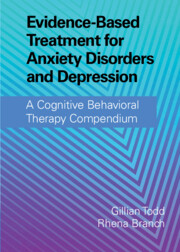 Evidence-Based Treatment for Anxiety Disorders and Depression
Evidence-Based Treatment for Anxiety Disorders and Depression from Part Six - Specialist Applications of Cognitive Behavioral Therapy for Anxiety Disorders and Depression
Published online by Cambridge University Press: 06 January 2022
This chapter outlines some of the ways in which cognitive behavior therapy (CBT) for anxiety disorders and depression has been modified and adapted to the ageing older population. Aspects that are outlined include modifications to the process of conceptualization, which has been expanded to include relevant gerontological factors. The areas that should be incorporated into the assessment of older adults with anxiety and depression prior to starting therapy are delineated, with a focus on the characteristic features that color the presentation in the case of older adults. The changes that must be made in carrying out CBT for older adults with depression and anxiety disorders so that it is effective are described. This includes accommodations for cognitive changes and health-related difficulties as well as taking into consideration factors that are specific to the older population.
To save this book to your Kindle, first ensure [email protected] is added to your Approved Personal Document E-mail List under your Personal Document Settings on the Manage Your Content and Devices page of your Amazon account. Then enter the ‘name’ part of your Kindle email address below. Find out more about saving to your Kindle.
Note you can select to save to either the @free.kindle.com or @kindle.com variations. ‘@free.kindle.com’ emails are free but can only be saved to your device when it is connected to wi-fi. ‘@kindle.com’ emails can be delivered even when you are not connected to wi-fi, but note that service fees apply.
Find out more about the Kindle Personal Document Service.
To save content items to your account, please confirm that you agree to abide by our usage policies. If this is the first time you use this feature, you will be asked to authorise Cambridge Core to connect with your account. Find out more about saving content to Dropbox.
To save content items to your account, please confirm that you agree to abide by our usage policies. If this is the first time you use this feature, you will be asked to authorise Cambridge Core to connect with your account. Find out more about saving content to Google Drive.